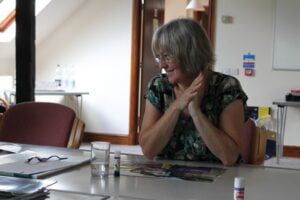
Jenny Alexander, author and writing coach
Can changing the cover of a self-published book change the indie author's fortunes? The following case study by author and writing coach Jenny Alexander demonstrates that it certainly can – though we should also point out that it doesn't guarantee a sales boost, and it might even reduce your sales. Serious consideration is therefore required.
Jenny, who has written scores of fiction, non-fiction and self-help books for children and adults, explains how her careful thought processes paid off when she took the plunge to rebrand her self-published books.

The original cover for Jenny Alexanders “child-of-the-heart” book
My Starting Point
I knew virtually nothing about self-publishing before I published Writing in the House of Dreams, and the most stressful thing by far was trying to decide on the cover. I knew that covers and titles were really important – those, more even than the content, were what made people decide to buy.
This was my child-of-the-heart book – I thought the cover should be unusual and lovely, like what was inside.
So I chose an artist whose work I really love, Hilke MacIntyre. and got a professional designer to put the cover together.

Continuing the brand
When I wrote my second book for writers, I decided it should have a brand look, because then if someone had enjoyed reading one, they would perhaps buy the other.
So I had two writing books whose covers and titles I really liked – but then I started writing my third, which is a practical handbook based on my workshop teaching, and this one would not suit the brand I'd chosen at all.
Besides, in the meantime, I was beginning to understand my brand much better. The more I taught and wrote about writing, the more I saw that although my books do have a quirky side, an arty side, all of them include lots of practical creative exercises and advice.
It takes a few books to really get to grips with what you're writing, who you want to be as a writer, how you want your brand to look and also what your books even mean – Joanna Penn.
I read a brilliant article by Joanna Penn, on her own rebranding journey, which inspired me to give my first two writing books a new look and, in so doing, create a suitable space for the third.


So here they are – and so far, so good.
The new covers have sold more copies than the old ones this month, even though they've only just been released yesterday.
You might notice, I've also changed the subtitle of Writing in the House of Dreams. The earlier one did describe everything in it – the book is full of my adventures in writing and dreams and offers the reader ideas for having some of their own – but it didn't get to the nub of what makes writing and dream-working the same thing, or offer a direct promise to the reader.
Time to Change the Title Too
With When a Writer Isn't Writing, I kept the subtitle but changed the title.
Even before it came out, I wasn't sure about the original title. I'd shown the cover at a talk I did on self-publishing with Kelly McCain at a Scattered Authors retreat, and Kelly emailed me afterwards to say she had a strong feeling to tell me that she thought the main title should be Finding Your Flow, because it didn’t jump in at a problem, but at a promised solution, and that vibe had much more positivity, momentum and flow.
I suspected she was right, but I didn't want to have to change everything when all the files had been signed off. As with my House of Dreams subtitle, the first title of this book didn't get to the nub of why writers would want to be able to handle blocks – because when things run smoothly, writing is a deeply pleasurable thing.
Another Advantage
Making new covers has had the extra advantage that I've been able to include some quotes from great reviews of the first editions, and rewrite the blurbs to be more focused.

Coming in November, in similar vein
My next book will be joining them in November. It's called Free-Range Writing: 75 Forays for the Wild Writer's Soul, and it pretty much does what it says on the tin.
I like that self-publishing is such a steep learning curve. I enjoy trying things and seeing how I could do them better. It feels creative and dynamic.
And an interesting and unforeseen benefit of this for me, as a hybrid author, is that it's really helping me to get a better understanding of the way traditional publishers think, so I may be able to operate more effectively in that world too.
Any thoughts?
Case study of a cover change that boosted sales of a #selfpub book - guest post by Jenny Alexande Share on XOTHER POSTS TO HELP YOU CHOOSE THE BEST COVER FOR YOUR SELF-PUBLISHED BOOK – FROM THE ALLi ARCHIVE





Thank you all for your comments – sorry I missed answering sooner!
I love how you’re fusing your creativity and artistic side with your marketing. Thank you for sharing your insights with us about cover art.
Jenny, a very interesting and well-written post, but it really begs the question that you never answer: Who is the designer?
(Also, best of luck with the books, the new covers are a big improvement.)
Hi Joel – her name is Rachel Lawston. She offers a discount to Alli members, and I highly recommend her!
Inspiring. I am planning to relaunch one of my adult magical realism series next year in print, and think I might change a few of the covers as they don’t all say ‘brand’.
Great post. I’ve changed/updated my nonfiction books as well as the fiction and really noticed a positive change. Love your new covers!